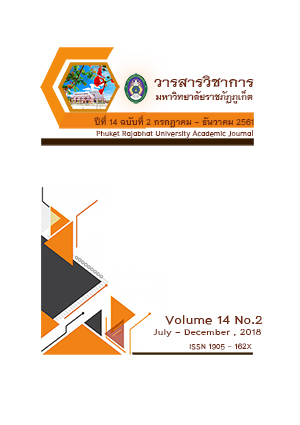ผลของการเข้าร่วมกิจกรรมเกมพลศึกษาที่มีต่อ การเห็นคุณค่าตนเองทางกายของนักเรียนประถมศึกษา
Main Article Content
บทคัดย่อ
การวิจัยครั้งนี้มีวัตถุประสงค์เพื่อศึกษาผลของการเข้าร่วมกิจกรรมเกมพลศึกษาที่มีต่อการเห็นคุณค่าตนเองทางกายของนักเรียนประถมศึกษา กลุ่มตัวอย่างเป็นนักเรียนชั้นประถมศึกษาปีที่ 6 ได้รับการสุ่มเป็นกลุ่มทดลอง 43 คน และกลุ่มควบคุม 39 คน โดยกลุ่มทดลองเข้าร่วมกิจกรรมเกมพลศึกษา จำนวน 12 สัปดาห์ สัปดาห์ละ 1 ครั้ง ครั้งละ 45 นาที นำข้อมูลที่ได้จากการทดลองมาวิเคราะห์ทางสถิติด้วยการหาค่าเฉลี่ย ส่วนเบี่ยงเบนมาตรฐาน วิเคราะห์คะแนนความก้าวหน้า และทดสอบค่า “ที” โดยกำหนดความมีนัยสำคัญทางสถิติที่ระดับ .05
ผลการศึกษา 12 สัปดาห์พบว่า
1)กลุ่มทดลองมีค่าเฉลี่ยผลต่างคะแนนความก้าวหน้าของการเห็นคุณค่าตนเองทางกายโดยรวม เพิ่มขึ้น และแตกต่างจากกลุ่มควบคุมอย่างมีนัยสำคัญทางสถิติที่ระดับ .05
2)กลุ่มทดลองมีค่าเฉลี่ยผลต่างคะแนนความก้าวหน้าของการเห็นคุณค่าตนเองทางกายในองค์ประกอบย่อยด้านสมรรถนะทางกายเพิ่มขึ้น และแตกต่างจากกลุ่มควบคุมอย่างมีนัยสำคัญทางสถิติที่ระดับ .05
สรุปได้ว่าการเข้าร่วมกิจกรรมเกมพลศึกษาช่วยพัฒนาการเห็นคุณค่าตนเองทางกายของนักเรียนประถมศึกษาได้
Article Details
เนื้อหาและข้อมูลในบทความที่ลงตีพิมพ์ในวารสารวิชาการมหาวิทยาลัยราชภัฏภูเก็ต ถือเป็นข้อคิดเห็นและความรับผิดชอบของผู้เขียนบทความโดยตรง ซึ่งกองบรรณาธิการวารสารฯ ไม่จำเป็นต้องเห็นด้วยหรือร่วมรับผิดชอบใด ๆ
บทความ ข้อมูล เนื้อหา รูปภาพ ฯลฯ ที่ได้รับการตีพิมพ์ในวารสารวิชาการมหาวิทยาลัยราชภัฏภูเก็ต ถือเป็นลิขสิทธิ์ของวารสารวิชาการมหาวิทยาลัยราชภัฏภูเก็ต หากบุคคลหรือหน่วยงานใดต้องการนำทั้งหมดหรือส่วนหนึ่งส่วนใดไปเผยแพร่ต่อหรือเพื่อกระทำการใด ๆ จะต้องได้รับอนุญาตเป็นลายลักษณ์อักษรจากวารสารวิชาการมหาวิทยาลัยราชภัฏภูเก็ตก่อนเท่านั้น
เอกสารอ้างอิง
Bodenheimer, T. and Handley, M. A.(2009). Goal-setting for behavior change in primary care: an exploration and status report (Online). https://www.ncbi.nlm.nih.gov/pubmed/19560895, March 13, 2017.
Bowker, A. (2006). The relationship between sports participation and self- esteem during early adolescence (Online).http://psycnet.apa.org/psycinfo/2006-12375-002, March 29,2017.
Bracken, B. A. (1996). Handbook of self-concept. New York: John Wiley & sons Inc.
Bridge, J. A., Goldstein T. R., and Brent, D. A. (2006). Adolescent suicide and suicidal behavior (Online). http://www.dhmh.maryland.gov/suicideprevention/Documents/Youth%20Suicide%20Risk%20Factor%20Review%202006.pdf, January 8, 2017.
Barnett, N. P., and Everett, J. J. (1993).Enhancement of children's self-esteem through social support training for youth sport coaches (Online). https://www.ncbi.nlm.nih.gov/pubmed/8407704, November 27, 2016.
Biddle, S. J. H. and Asare, M. (2011). Physical activity and mental health in children and adolescents: A review of reviews.British Journal of Sports Medicine, 45, 886–895.
Bursnall, P. (2014). The relationship between physical activity and depressive symptoms in adolescents: A systematic review (Online).https://www.ncbi.nlm.nih.gov/pubmed/25213686, December 9, 2016.
Cribbie, R. A., and Jamieson, J. (2000). Structural equation models and the regression bias for measuring correlates of change. Educational and Psychological Measurement, 60(6), 893-907.
DeHart, T., Pelham, B. W., and Tennan, H. (2006). What lies beneath. Parenting style and implicit self-esteem. Journal of Experimental and Social Psychology, 42, 1-17.
Mihaly, C. (2014).Applications of Flow in Human Development and Education. New York: Springer.
Ekeland, E., Heian, F. and Hagen, K. B. (2005). Can exercise improve self-esteem in children and young people?: A systematic review of randomised controlled trials. British Journal of Sports Medicine,39, 792–798.
Eime, R. M., Young, J. A., Harvey J. T., Charity, M. J., and Payne, W. R. (2013). A systematic review of the psychological and social benefits of participation in sport for children and adolescents: Informing development of a conceptual model of health through sport (Online). https://www.ncbi.nlm.nih.gov/pubmed/23945179, December 7, 2016.
Fox, K. R. (2000). The effects of exercise on self-perceptions and self-esteem. In S .J. H. Biddle, K. R. Fox and S. H. Boutcher (eds), Physical Activity and Psychological Well-being (pp. 88–117). London: Routledge.
Henderlong, J. and Lepper, M. R. (2002).The Effects of Praise on Children’s Intrinsic Motivation: A Review and Synthesis (Online).https://www.reed.edu/motivation/docs/PraiseReview.pdf, February 19, 2017.
Halliwell, E. and Diedrichs, P.C.(2014).Testing a dissonance body image intervention among young girls (Online). https://www.ncbi.nlm.nih.gov/pubmed/23668845, June 22, 2017.
Hart, L. M., Cornell, C., Damiano, S. R., and Paxton, S. J. (2015). Parents and prevention: A systematic review of interventions involving parents that aim to prevent body dissatisfaction or eating disorders (Online). http://onlinelibrary.wiley.com/doi/10.1002/eat.22284/abstract, June 22, 2017.
Lopez-Guimera, G., Levine, M. P., Sanchez-Carracedo, D., and Fauquet, J. (2010).Influence of mass media on body image and eating disordered attitudes and behaviors in females: A review of effects and processes. Media Psychology, 13(4), 387-416.
McCabe, P. M., Connaughton, C., Tatangelo, G., and Mellor, D.(2016). Healthy me: A gender-specific program to address body image concerns and risk factors among preadolescents (Online). http://www.sciencedirect.com/science/article/pii/S1740144515301121, June 22, 2017.
McIntyrea, F., Chiversb, P., Larkinc, D., Roseb, E., and Handsb, B. (2014). Exercise can improve physical self-perceptions in adolescents with low motor competence (Online). http://www.sciencedirect.com/science/article/pii/S0167945714002176, March 29, 2017.
Monsma, V.(2007).Principles of Effective Goal Setting (Online). http://www.appliedsportpsych.org/resources/resources-for-athletes/principles-of-effective-goal-setting/,March 16, 2017.
NASPE. (2004). Moving into the future: National standards for physical education. 2nd ed. Virgenia: NASPE Publications.
Rosenberg, M. (1985).Self-concept and psychological well-being in adolescence. In Leary, R. L (Ed.), The Development of the Self (pp. 205 -246). New York: Academic Press.
Raustorp, A. and Lindwall, M.(2015). Physical self-esteem – a ten-year follow-up study from early adolescence to early adulthood (Online). https://www.degruyter.com/view/j/ijamh. 2015.27.issue-1/ijamh-2014- 0001/ijamh-2014-0001.xml ,November 27, 2016.
Ricciardelli, L. A., McCabe, M. P., Lillis, J., and Thomas, K.(2006). A Longitudinal Investigation of the development of weight and muscle concerns among preadolescent boys (Online). https://link.springer.com/article/10.1007/s10964-005-9004-7, June 22, 2017.
Rovinelli, R. J. and R. K.Hambleton. (1977). “On the use of content specialists in the assessment of criterion-referenced test item validity”.Dutch Journal of Educational Research, 49-60.
Strong, W. B., Malina, R. M., Blimkie, C. J., Daniels, S. R., Dishman, R. K., Gutin, B., Hergenroeder, A. C., Must, A., Nixon, P. A., Pivarnik, J. M., Rowland,T., Trost, S., and Trudeau, F.(2005). Evidence based physical activity for school-age youth (Online). https://www.ncbi.nlm.nih.gov/pubmed/15973308, December 7, 2016.
Stice, E., Spangler, D., and Agras, W. S.(2001. Exposure to media-portrayer thin-ideal images adversely affects vulnerable girls: A longitudinal experiment. Journal of Social and Clinical Psychology, 20(3), 270-288.
Schulenberg, J. and Maggs, J.(2001).Moving targets: modeling developmental trajectories of adolescent alcohol misuse, individual and peer risk factors, and intervention effects Journal of Applied Developmental Science, 5, pp. 237–253
Trzesniewski, K. H., Donnellan, M. B., and Robins, R. W. (2003). Stability of self-esteem across the life span (Online). https://www.ncbi.nlm.nih.gov/pubmed/125189800, November 27, 2016.
Tatangelo, G. and Ricciardelli,L. A.(2013). A qualitative study of preadolescent boys' and girls' body image: gendered ideals and sociocultural influences(Online.https://www.ncbi.nlm.nih.gov/pubmed/24018337, June 6, 2017.
Tiggemann, M. (2006). The role of media exposure in adolescent girls' body dissatisfaction and drive for thinness: Prospective results. Journal of Social and Clinical Psychology,25(5), 523-541.
Zeigler-Hill. (2011). The Connections between Self-Esteem and Psychopathology (Online). https://www.researchgate.net/publication/227318231The_Connection s_Between_Self-Esteem_and_Psychopathology, January 15, 2017.


